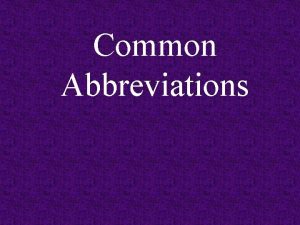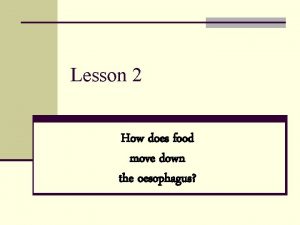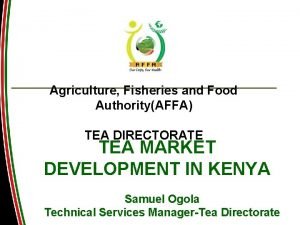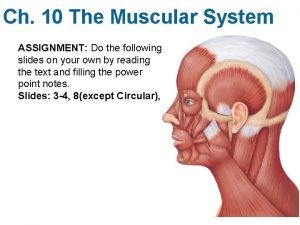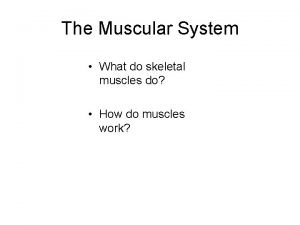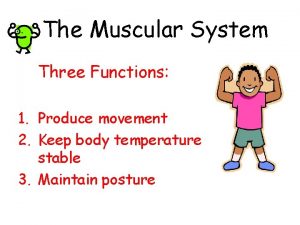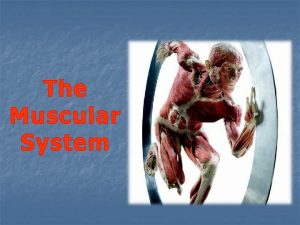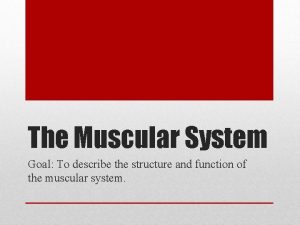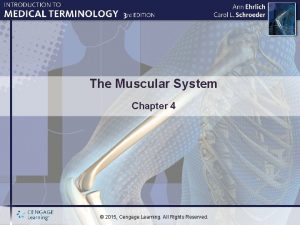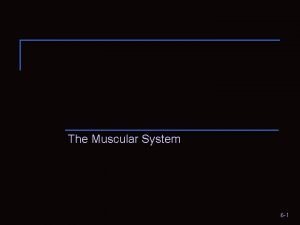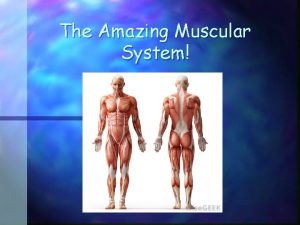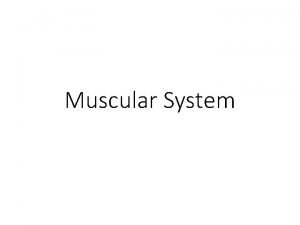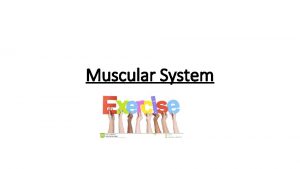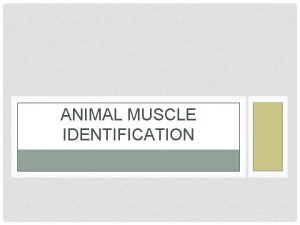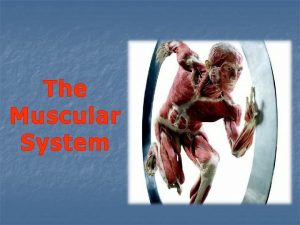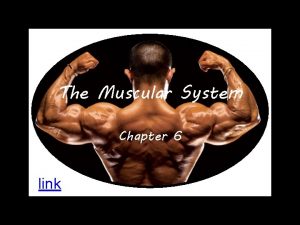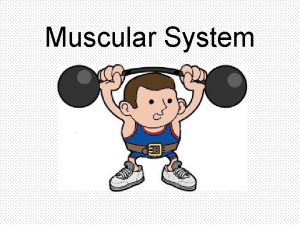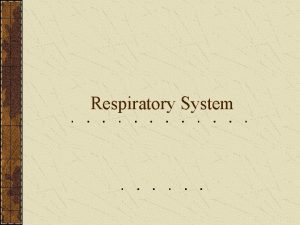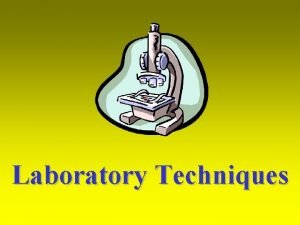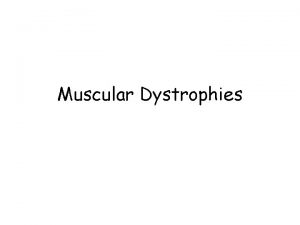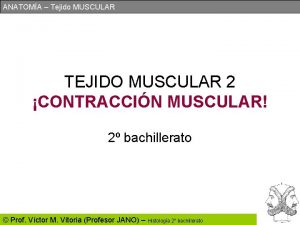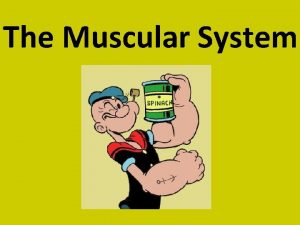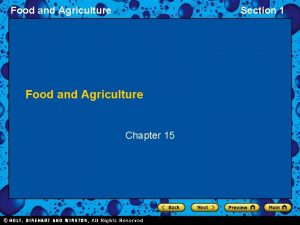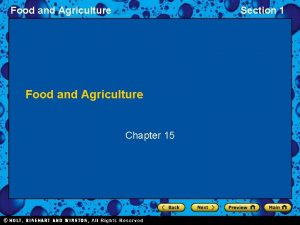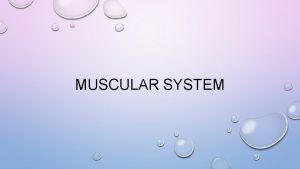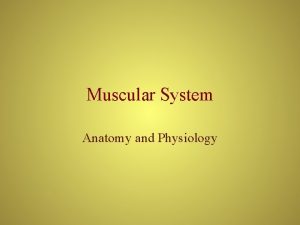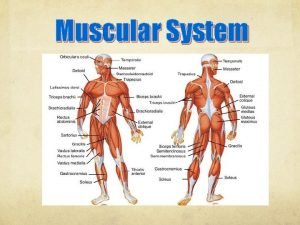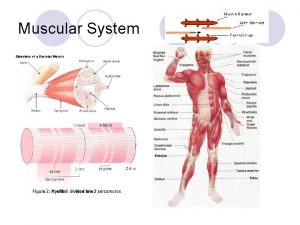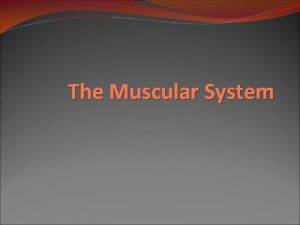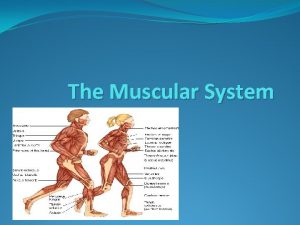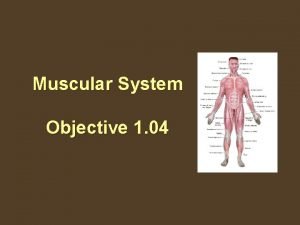Muscular System Agriculture Food and Natural Resource Standards








































- Slides: 40

Muscular System

Agriculture, Food, and, Natural Resource Standards Addressed • AS. 01. Evaluate the development and implications of animal origin, domestication and distribution on production practices and the environment. – AS. 01. 02. a. Research and summarize major components of animal systems.

• Muscles are contractile organs responsible for the voluntary and involuntary movements of animals.

1. Skeletal muscle - allows for all voluntary movement - appears to be striated when looked at under a microscope.

2. Cardiac muscle - controls the involuntary beating of the heart - appears striated under a microscope.

3. Smooth muscle - responsible for all other involuntary movement, such as breathing, digestion, peristalsis, blinking, etc.

Ambulation moving from one place to another

Abduction moving away from the median plane

Adduction moving towards the median plane

Flexion moving the distal part of the limb towards the body

Extension moving the distal part of the limb away from the body

All muscles can do is CONTRACT or RELAX, so they generally work in pairs.

For any particular action, the muscles involved can be classified as: 1) Agonist 2) Antagonist

Agonist prime mover of a joint

Antagonist opposes movement of the agonist

Example For elbow flexion, the agonist is the bicep the antagonist is the tricep.

Example For elbow extension, the agonist is the tricep the antagonist is the bicep.

Masseter – superficial muscle of the cheek

Masseter

Trapezius – superficial triangular muscle of the shoulder

Trapezius

Latissimus dorsi – long, superficial, dorsal muscle that attaches the humerus to the lumbar region of the back

Latissimus dorsi

Abdominal obliques – large flat muscles that support digestive and reproductive organs

External abdominal oblique

Gluteals – large muscle of the upper hindquarters

Gluteals

Biceps femoris – lateral superficial muscle, one of three which forms the “hamstrings”

Biceps femoris

Biceps brachii – primary flexor of the elbow joint

Triceps brachii – primary extensor of the elbow joint

Triceps brachii

Pectorals – primary adductors of the forelimbs

Pectorals

Serratus ventralis – attaches forelimb to trunk (no collarbone!)

Brachiocephalicus

Deltoid

Intercostal

Semitendinous

Gastrocnemius
 Differentiate muscular strength from muscular endurance
Differentiate muscular strength from muscular endurance Primary resource for agriculture
Primary resource for agriculture Agriculture abbreviation
Agriculture abbreviation A long and narrow muscular tube that relaxes and contracts
A long and narrow muscular tube that relaxes and contracts Konya food and agriculture university
Konya food and agriculture university Tea directorate
Tea directorate Ministry of food agriculture and fisheries denmark
Ministry of food agriculture and fisheries denmark Agriculture fisheries and food authority
Agriculture fisheries and food authority Resource leveling is the approach to even out the peaks of
Resource leveling is the approach to even out the peaks of Contoh resource loading
Contoh resource loading Unit 2 food food food
Unit 2 food food food Food chain sequence
Food chain sequence Factors necessary for service standards are
Factors necessary for service standards are Virginia department of agriculture food safety
Virginia department of agriculture food safety Ohio department of agriculture food safety
Ohio department of agriculture food safety Muscular system assignment
Muscular system assignment Skeletal and muscular system
Skeletal and muscular system Skeletal and muscular system
Skeletal and muscular system Gis hrm
Gis hrm Classes in rio vista natural resource park
Classes in rio vista natural resource park Natural resource ecology laboratory
Natural resource ecology laboratory Natural income
Natural income Food safety regulations and standards
Food safety regulations and standards Food and beverage service' 9 th edition
Food and beverage service' 9 th edition Food safety 2006
Food safety 2006 How do muscles move
How do muscles move Which is a primary function of the muscular system
Which is a primary function of the muscular system Tendon is made up of
Tendon is made up of Chapter 4 the muscular system
Chapter 4 the muscular system Muscular system figure
Muscular system figure Amazing facts about the muscular system
Amazing facts about the muscular system Label endomysium perimysium epimysium and fascicle
Label endomysium perimysium epimysium and fascicle Muscular system label
Muscular system label Rectus femoris fascicle arrangement
Rectus femoris fascicle arrangement Sheep muscular system
Sheep muscular system Navigating the body regions of the body
Navigating the body regions of the body Muscular system primary function
Muscular system primary function Chapter 6 the muscular system figure 6-9
Chapter 6 the muscular system figure 6-9 Purpose of muscular system
Purpose of muscular system 7:5 muscular system
7:5 muscular system Aerobic respiration exercise
Aerobic respiration exercise


